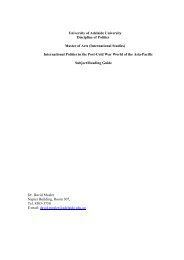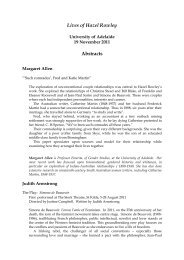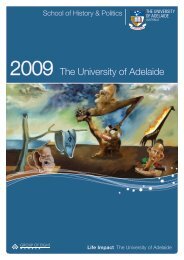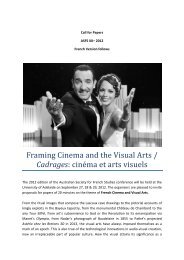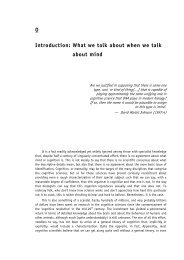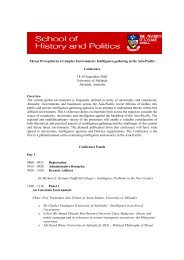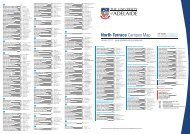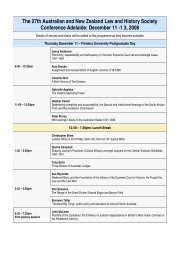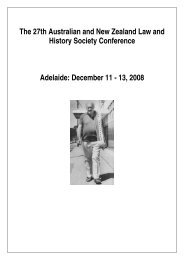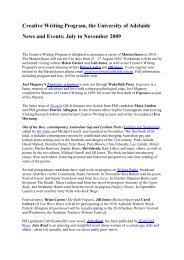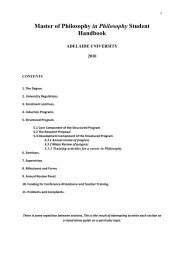Biohumanities - Paul Griffiths - Representing Genes
Biohumanities - Paul Griffiths - Representing Genes
Biohumanities - Paul Griffiths - Representing Genes
You also want an ePaper? Increase the reach of your titles
YUMPU automatically turns print PDFs into web optimized ePapers that Google loves.
38 THE QUARTERLY REVIEW OF BIOLOGY<br />
Volume 83<br />
alternatives that they displaced (Olby 1974,<br />
1985). But philosophy of science also<br />
makes claims about genetics itself in, for<br />
example, discussions of whether the Mendelian<br />
gene and the molecular gene are<br />
the same entity (<strong>Griffiths</strong> and Stotz 2006,<br />
2007; Kitcher 1984; Waters 1994).<br />
The biohumanities label (first used as<br />
the title of a research grant held by <strong>Griffiths</strong>:<br />
http://paul.representinggenes.org/<br />
biohum_home.html) is intended to suggest<br />
a more intimate relationship between<br />
biology and the humanities than is suggested<br />
by labels such as “biology and society”<br />
or “ethical, legal and social implications”<br />
(ELSI). We should emphasize that<br />
we are primarily concerned with differences<br />
in the connotations of these labels,<br />
rather than differences in the actual work<br />
carried on under the labels. Much of the<br />
work conducted under “biology and society”<br />
or “genomics and society” is closer to<br />
biohumanities (as we will discuss below)<br />
than to anything suggested by those labels.<br />
The ELSI label has a particularly strong<br />
connotation that biologists provide the<br />
facts while humanists and social scientists<br />
are confined to discussing the implications<br />
of those facts. In contrast, biohumanities<br />
research aims to feed back into our understanding<br />
of biology itself. Moreover, in the<br />
biohumanities vision, while history and<br />
philosophy of biology may provide resources<br />
for addressing ELSI issues, that is<br />
not their primary aim.<br />
We see four major aims for research in<br />
the biohumanities: understanding biology,<br />
constructive science criticism, contributing<br />
to new visions of biology, and contributing<br />
to critical science communication. First,<br />
and most generally, biohumanities is concerned<br />
with understanding biology. Although<br />
the biohumanities are of potential<br />
value to both biology and society, this is<br />
not the sole or main justification for engaging<br />
in this research. Science is fascinating<br />
and important, and it is worth understanding<br />
science even if understanding it does<br />
not have an immediate practical payoff,<br />
just as evolution is worth understanding<br />
whether or not doing so contributes to<br />
crop improvement or drug development.<br />
As in the biosciences themselves, it is hard<br />
to imagine biohumanities researchers doing<br />
their best work without an intrinsic<br />
interest in the material they study.<br />
Second, biohumanities is a critical enterprise.<br />
Constructive “science criticism” (Pigliucci<br />
and Kaplan 2006:8) stands back from<br />
the urgencies of actual research to reflect<br />
on the strengths and weaknesses of current<br />
approaches. Thus, as C Kenneth Waters<br />
has remarked, the aims of philosophical<br />
analysis include “to articulate scientific<br />
concepts in ways that help reveal epistemic<br />
virtues and limitations of particular sciences.<br />
This means an analysis of the gene<br />
concept(s) should help clarify the explanatory<br />
power and limitations of gene-based<br />
explanations, and should help account for<br />
the investigative utility and biases of genecentered<br />
science” (2004:29).<br />
Science criticism can also involve the<br />
“turning-over of stones that had hitherto<br />
held their ground” (Moss 2006:523). History<br />
of science points out the “roads not<br />
taken” in science. Without calling into<br />
question the data that were gathered, it<br />
demonstrates that other data might have<br />
been gathered, or that the data that were<br />
actually gathered could have been interpreted<br />
in different ways. Philosophy of science<br />
adds to this enterprise by critically<br />
analyzing the chains of reasoning that connect<br />
specific scientific findings to claims<br />
about the broader significance of those<br />
findings. This can lead to changes in interpretation<br />
that can potentially motivate biologists<br />
to reinterpret earlier scientific<br />
findings and to prioritize different questions<br />
for future research. Thus, ideally,<br />
critical history and philosophy of biology<br />
can contribute to our third goal, the articulation<br />
of alternative visions of biology.<br />
Finally, history and philosophy of biology<br />
can contribute to the creation of “critical<br />
science communication” both through<br />
constructive science criticism and by communicating<br />
to a wider audience not merely<br />
“what has been discovered,” but something<br />
of the complexity of the scientific process<br />
and the contestability of its findings. To be<br />
valuable, critical work as described in the<br />
last two paragraphs must be “bioliterate,”



